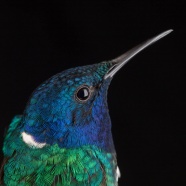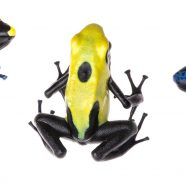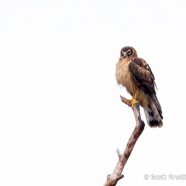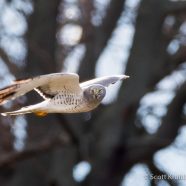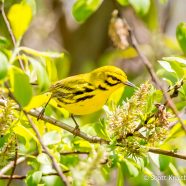White-necked Jacobin (Florisuga mellivora)
Here’s the White-necked Jacobin (Florisuga mellivora) hummingbird, and this photo by RTPI Affiliate Sean Graesser shows where their name comes from. He says he has seen five males at one time at the feeders in Costa Rica despite it being “out of range” for species in the area. RTPI President Twan Leenders says the local eBird reviewers give him a tough time about it…thankfully there is photographic proof!
Read MoreDyeing Poison Dart Frog (Dendrobates tinctorius)
The Dyeing Poison Dart Frog (Dendrobates tinctorius) displays great color and pattern variation throughout its extensive distribution range – each form is stunningly beautiful in its own right.
Read MoreJuvenile Northern Harrier
I recently wrote about our winter raptors, and boy oh boy, did we ever get the winter in Chautauqua County! Short-eared Owls (Asio flammeus) and Northern Harriers (Circus cyaneus), like the juvenile recently photographed below, are able to hunt and survive in deep snow, but we may be pushing the limit for some birds in the region now. The snow cover and frigid temperatures are shaking up the local mix of birds of all sorts of species, from ducks to songbirds. A Short-eared Owl was spotted in the county earlier this week, and no doubt others may be easier to find now as they hunt the white...
Read MoreGray Ghost & Winter Raptors
We are now in the beginning of meteorological winter and nearing the start of astronomical winter. Our birds, as usual, are already prepared for the season however we wish to define it, having migrated, irrupted, or dispersed to wintering grounds throughout the region, continent, or perhaps even out of our hemisphere. Those that remain with us have evolved to cope with the freezing conditions and heavy snowfall. One such species is the Northern Harrier, and last week I photographed this adult male “gray ghost” while it was hunting. Look at that gaze – magnificent! The Roger...
Read MorePrairie Warbler
This male Prairie Warbler (Setophaga discolor) put on a sensational display for us last Sunday all while singing away and finding plenty to eat after his journey the previous night. It took a few hours to finally see the bird after hearing the rising, buzzy song repeatedly in the morning. The sun was shining brightly high in the sky by the time he came out into the open, giving the yellow warbler an even brighter glow while foraging in these willows. The Prairie Warbler is one of those species that perplexes me in the Chautauqua-Allegheny region. I feel like there should be more of them in...
Read More



